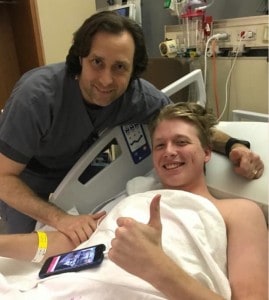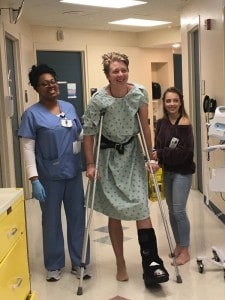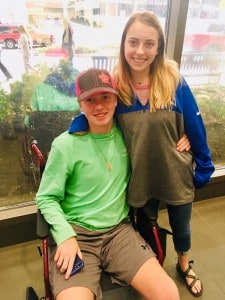Nathan Lumpkin, 19, was rushed to the Elvis Presley Trauma Center after his foot was crushed in a work accident.
Anesthesiologist Jerry Jones, MD helped Nathan avoid opioids by using continuous peripheral nerve blocks, a technique Dr. Jones has pioneered at Regional One Health.
The nerve blocks prevent addiction by never exposing a patient to narcotics in the first place. That was key to a successful recovery and bright future for Nathan.
Nathan Lumpkin was just starting to write his story, studying to be a pharmacist, spending time with his girlfriend and working his first job.
The unexpected plot twist of an excruciating injury could have turned that story tragic, but his own resilience, expert medical care and a doctor who shared a tale of his own saved the day.
“I’m 19, and I had to learn how to walk again and deal with a lot of pain,” Nathan said. “It’s not always easy, but without Regional One Health, I wouldn’t be standing on my own.”
Nathan was at work this January when a 950-pound piece of machinery fell on his left foot. “I took my boot and sock off, and my whole foot was blue,” he said.
The pain was horrible: “It felt like a hammer driving a nail into my foot over and over.”
His mom Kelly, a surgical nurse, arrived at the Elvis Presley Trauma Center to a parent’s worst nightmare. “I roll into trauma, and there were doctors in gowns all around him, and I realize, ‘This is bad.’ I had to come to terms with that quick.”

Nathan credits Dr. Jerry Jones with helping him avoid the use of opioids as he recovered from his painful injuries.
All of Nathan’s toes were broken and much of the tissue in his foot was already dead. Surgeons feared they would have to amputate.
In the midst of the fear and pain, Nathan was introduced to an important character in his story.
Jerry Jones, MD is director of the Acute Pain Service and a leader in the use of continuous peripheral nerve blocks.
By inserting a tiny catheter near the nerves of an injured area, he can use a non-addictive anesthetic to get patients through the acute pain period.
“Dr. Jones gave me the nerve block about five minutes after I was wheeled into the trauma bay,” Nathan said.
“He was leaning over an ultrasound machine and I heard him say, ‘I got it.’ Five, ten minutes later, the brutal part of the pain was gone.”
A few days later, Dr. Jones explained why he’d done the procedure. “He asked if I’d seen news reports about the opioid crisis,” Nathan recalls. “He said, ‘This is a way to keep you off opioids.’ And in my case, it did. The best way I can describe that nerve block is life-changing.”
Dr. Jones reinforced that message the day Nathan was released. Nathan was struggling as doctors adjusted the nerve block, and for the first time, he considered taking narcotics.
Dr. Jones took Kelly aside, warning her Nathan was a classic high-risk patient. “He was 18 and had legitimate reason to take opioids,” Kelly said. “Dr. Jones said, ‘In 15 years you’ll remember today, because you might be burying your son, or he could be on the streets and you won’t know where.’”

“I’m 19, and I had to learn how to walk again,” Nathan said. “Without Regional One Health, I wouldn’t be standing on my own.”
Kelly stepped out of the room, but not out of earshot, and listened to Dr. Jones tell Nathan a story inspired by the Freddy Krueger horror movie A Nightmare on Elm Street, and how Nathan would now have to “fight his Freddy” – the lure of opioids that could destroy his life – every day.
“He had a painful injury that required multiple surgeries, so he could have been exposed to a lot of narcotics. That would have been a perfect opportunity to throw his life away,” Dr. Jones said.
“I coached him not to hide behind narcotics, and told him, ‘You can be destroyed by this, or you can be stronger than you ever knew.’”
Kelly recalls listening in silence and then taking her son home. “I never said a word to Nathan,” she said. “And Nathan never asked for another pain pill.”
To this day, she has the words “Fight your Freddy” displayed on her cell phone, a reminder of how much she and her son could have lost.
Dr. Jones’ words are at the forefront of Nathan’s mind too: “I beat Freddy,” he said. “I’m not through it, but I’m close.”
Nathan has already overcome a partial amputation of a toe, several surgeries and numerous skin grafts. Most of his toes are still broken. He took time off college to focus on healing, and has to wait until November to even try to put weight on his toes.
But thanks to his loved ones and medical team, the struggle is just part of his story, not the end.
His girlfriend Megan stayed by his side the entire time, and Kelly was there for everything from emotional support to changing bandages: “She’s a nurse, but she’s a mom first,” Nathan said.

Nathan said he’s grateful for support from his mom and girlfriend. He is getting ready to go back to college, and his treatment has inspired him to pursue physical therapy.
The team Regional One Health are also heroes in his story. Nathan is getting stronger all the time with the help of burn rehab therapists, who took him from bedridden to walking on his own.
“What an amazing group of people. There’s always a positive attitude, and you can tell they’re there to help you. They’re like family,” he said.
As for the Acute Pain Service, Kelly says they’re nothing less than a miracle. “They’re the only ones in the area doing this. I truly believe it’s a miracle that we found them that day.”
Now, Nathan is ready to continue writing his story – although there is a plot twist, inspired by his care at Regional One Health.
“I want to get back to school in January,” he said. “But after everything that’s happened, I’m thinking about changing my major to physical therapy.”

